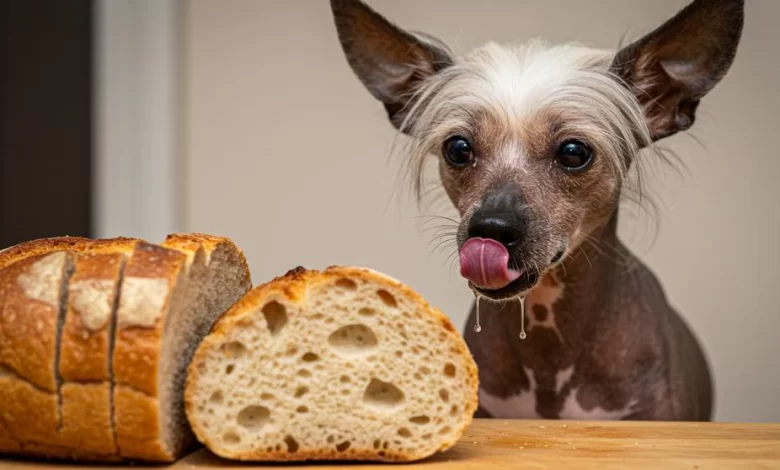
Can dogs eat whole wheat bread? As pet owners, we often wonder whether sharing our favorite foods with our furry friends is safe. Bread is a staple in many households, and whole wheat bread is often considered a healthier choice for humans. But is it safe for dogs? While whole wheat bread is not toxic to dogs, it’s important to understand the potential benefits and risks before offering it as a treat.
In this article, we’ll explore Can dogs eat whole wheat bread? And everything you need to know about feeding whole wheat bread to dogs, including its nutritional value, potential health benefits, possible dangers, and the safest ways to serve it. We’ll also cover which types of bread should be avoided and offer some healthier alternatives. Read on to make an informed decision about your dog’s diet!
Is Whole Wheat Bread Safe for Dogs?
Whole wheat bread is generally safe for dogs to eat in small amounts, as long as it does not contain harmful ingredients. Unlike white bread, whole wheat bread contains more fiber and essential nutrients, making it a slightly better option. However, bread should never be a significant part of a dog’s diet, as it provides little nutritional value and can contribute to unnecessary calorie intake.
While plain whole wheat bread is not harmful to most dogs, certain factors should be considered before feeding it to your pet:
✔ No Toxic Ingredients: Always check the ingredient list for anything that may be harmful to dogs, such as raisins, garlic, onions, xylitol, chocolate, or excessive salt.
✔ Wheat Allergies: Some dogs may be allergic to wheat, which can cause digestive upset, itching, or skin irritation.
✔ Portion Control: Whole wheat bread is high in carbohydrates and should only be an occasional treat.
✔ Balanced Diet: Dogs require a well-rounded diet rich in protein, healthy fats, and essential vitamins—bread does not fulfill these nutritional needs.
Nutritional Value of Whole Wheat Bread
Whole wheat bread contains some nutrients that may offer minor benefits for dogs, but it is not an essential part of their diet. Here’s a look at what whole wheat bread contains:
✔ Fiber: Helps regulate digestion and may be beneficial for dogs with mild constipation.
✔ Protein: Contributes to muscle maintenance, though whole wheat bread is not a significant protein source.
✔ Vitamins & Minerals: Provides small amounts of B vitamins, iron, and magnesium.
✔ Carbohydrates: Serve as an energy source, but excessive intake can lead to weight gain.
Despite these nutrients, whole wheat bread does not provide any major health benefits for dogs and should be given in moderation.
Potential Benefits of Whole Wheat Bread for Dogs
Although not necessary for a dog’s diet, whole wheat bread may offer a few minor benefits when given responsibly:
✔ Digestive Support: The fiber content in whole wheat bread may help dogs with mild constipation by promoting regular bowel movements.
✔ Low-Fat Treat Option: Compared to some processed dog treats, whole wheat bread is low in fat, making it a reasonable occasional snack.
✔ Training Aid: Small pieces of whole wheat bread can be used as training treats, provided they are given sparingly.
✔ Mild Energy Boost: Carbohydrates in whole wheat bread can provide a temporary source of energy, but they are not necessary for most dogs.
While these benefits exist, they are minimal compared to the advantages of feeding dogs species-appropriate foods such as lean meats, vegetables, and specially formulated dog treats.
Risks of Feeding Whole Wheat Bread to Dogs
Even though whole wheat bread is not toxic, there are several risks associated with feeding it to dogs:
❌ Wheat Allergies & Sensitivities: Some dogs are allergic to wheat, leading to symptoms like itching, ear infections, skin irritation, vomiting, or diarrhea.
❌ Obesity & Weight Gain: Bread is high in carbohydrates and can contribute to weight gain if overfed.
❌ Digestive Issues: Some dogs may experience bloating, gas, or stomach discomfort after eating bread.
❌ Choking Hazard: Large pieces of bread may be difficult for small dogs to chew and swallow properly.
❌ Lack of Essential Nutrients: Bread does not provide the high-quality protein, vitamins, or healthy fats that dogs need for a balanced diet.
If your dog has a history of food allergies or digestive issues, consult your veterinarian before introducing whole wheat bread to their diet.
Types of Bread That Should Be Avoided
Certain types of bread contain ingredients that are dangerous for dogs. Always avoid feeding your dog the following types of bread:
🚫 Raisin Bread: Raisins and grapes are toxic to dogs and can cause kidney failure.
🚫 Garlic & Onion Bread: All members of the onion family (including garlic, leeks, and chives) are highly toxic to dogs.
🚫 Bread Dough: Raw dough can expand in a dog’s stomach, leading to severe bloating and potentially life-threatening conditions.
🚫 Banana Bread with Nuts: Some nuts, such as macadamia nuts, are toxic to dogs, while others pose a choking hazard.
🚫 Pumpkin Bread with Nutmeg: Nutmeg is toxic to dogs and can cause neurological problems.
🚫 Sugary or Sweetened Bread: Bread that contains high amounts of sugar, xylitol, or chocolate should never be given to dogs.
If your dog accidentally consumes any of these dangerous breads, contact your veterinarian immediately.
How to Safely Serve Whole Wheat Bread to Dogs
If you decide to give your dog whole wheat bread, follow these safety tips:
✔ Small Portions Only: A tiny piece of bread is enough for an occasional treat.
✔ Check Ingredients: Ensure the bread does not contain harmful additives or preservatives.
✔ No Spreads or Toppings: Avoid butter, peanut butter with xylitol, jam, or other sugary spreads.
✔ Monitor for Reactions: Watch for any signs of digestive discomfort or allergic reactions.
✔ Use as a Training Reward: Instead of a regular snack, consider using small pieces as positive reinforcement treats.
Healthy Alternatives to Whole Wheat Bread
Instead of bread, consider offering your dog these healthier treats:
✔ Carrots & Cucumbers: Low-calorie, crunchy treats packed with vitamins.
✔ Apples (Seedless): Provide natural sweetness and fiber.
✔ Blueberries & Strawberries: Rich in antioxidants and safe for dogs in moderation.
✔ Pumpkin (Plain, Cooked): Great for digestion and a healthier alternative to bread.
✔ Oatmeal: A fiber-rich option that’s gentle on the stomach.
✔ Dog-Specific Treats: Many healthy treats are specially formulated for dogs, ensuring balanced nutrition.
What to Do If Your Dog Eats Unsafe Bread
If your dog accidentally consumes bread that contains toxic ingredients, take these steps:
✅ Observe Symptoms: Watch for vomiting, diarrhea, lethargy, or other signs of distress.
✅ Contact a Veterinarian: Seek immediate help if your dog has eaten toxic bread (such as raisin or garlic bread).
✅ Call the Pet Poison Helpline
Conclusion: Can Dogs Eat Whole Wheat Bread?
So, can dogs eat whole wheat bread? The answer is yes, but only in moderation. While whole wheat bread is safer than white bread and free of harmful additives, it offers little nutritional value. If your dog has allergies, a sensitive stomach, or weight issues, it’s best to avoid it altogether.
For a healthier alternative, consider feeding your dog natural, nutrient-rich treats like fruits, vegetables, or dog-safe biscuits. Always consult your veterinarian before introducing new foods to your dog’s diet to ensure their safety and well-being.



